undocumented immigrants

ON THE THIRD day of President Donald J. Trump’s second term, I saw a tweet that assaulted my spirit. A Utah church deacon and self-described “Christian husband and father” named Ben Garrett went viral for posting a picture of the Episcopal bishop of Washington, D.C., Rev. Mariann Edgar Budde, with the following caption: “Do not commit the sin of empathy. This snake is God’s enemy and yours too. She hates God and His people. You need to properly hate in response. She is not merely deceived but a deceiver. Your eye shall not pity.”
The day before, Budde had preached a pastoral and prophetic sermon at the inaugural prayer service for Trump and Vice President J.D. Vance. She made a direct plea to President Trump to “have mercy upon the people in our country who are scared now” — specifically naming transgender and undocumented children who feared what the new administration would mean for them. Garrett’s tweet — which received almost 5,000 likes and nearly 24 million views — was a rebuke of Bishop Budde’s call to have empathy toward two groups of people who Trump and his supporters have consistently demonized, attacked, and marginalized.
When I researched the phrase “the sin of empathy,” I was led to some right-wing Christian influencers and writers, whose arguments often boil down to the old directive to “love the sinner, hate the sin.” Far too often, I’ve found this to be a mere pretext to act against individuals and groups in fear- and hate-driven ways that can result in violence. Empathy doesn’t mean you have to agree with someone’s choices or perspective. Instead, it enables us to get more proximate to people’s pain and perspective as we honor the image of God that is within every person.

IT'S A GRAY, mid-May morning in Panteón Municipal #1, a city cemetery in Tijuana’s Zona Norte neighborhood. Alberto, the gatekeeper, saunters down a rocky pathway lined with palms, jacaranda, and gravestones to a prominent, red brick chapel, built over the tomb of one Juan Castillo Morales.
The shrine is covered wall-to-wall with candles, flowers, and plaques with names and messages of thanks to “Juan Soldado” (Juan the Soldier), as Castillo is known. Amid the array sits a stylized bust of a young soldier, resplendent in military attire, this morning bearing a black rosary and a blue-and-white Los Angeles Dodgers snapback hat.
The shrine is one of many unofficial memorials where loved ones remember lives of immigrants lost along the U.S.-Mexico border. From chapels erected around the graves of unofficial saints such as Castillo to digital memorials people carry with them into the desert to the crosses, flowers, and other mementos left along the border boundary itself, these monuments not only pay tribute to the individuals lost but bear witness to the ubiquity of death — and faith — in America’s southwestern borderlands.
Rosalba Ruiz-Hernández, a 46-year-old mother of five, stands in the shrine. Ruiz-Hernández, originally from the southern Mexican state of Oaxaca, was deported back to Tijuana after her own failed attempt to start a new life in the U.S. Two of her grown children still live in Long Beach, Calif., near her former husband. They are undocumented, she said, but they make a living. Two others are in Tijuana with her. Matías, her middle son, died in the desert on his way north to join his siblings in Southern California.

ALINE MELLO WAS 7 years old when she left Brazil with her parents and sister for what was supposed to be a short-term stay in the United States. Growing up undocumented, Mello turned to writing to process her questions about belonging and relationships. More Salt than Diamond (Andrews McMeel Publishing), her debut poetry collection, pulses with themes of identity, religion, and living as an immigrant in tumultuous times. Sojourners columnist Liuan Huska spoke with Mello, a graduate fellow in creative writing at Ohio State University, about race, language, and coming back around to God after disillusionment with the church.
Liuan Huska: What were the circumstances of your family’s emigration from Brazil?
Aline Mello: We emigrated in 1997. We were pretty poor. We had a lot of faith that if we were going to the U.S., it was because God wanted us to go. My uncle got a tourist visa for the four of us to go to Somerville, Mass. It was just going to be three years.
My father had this thing where he would follow charismatic pastors, and we followed one to Atlanta in 2000, right before 9/11. I had been told [incorrectly], “If you stay here for 10 years, you automatically get papers.” I thought, “Okay, I’m going to be fine.”
Right when I graduated high school, in 2007, my father left us. My mom literally got home from work one day and got a voice mail from him saying, “Hey, I left the country.” I realized I couldn’t go to college in Brazil because I didn’t know college-level Portuguese. And I had scholarships here. The goal was to go to college and then go back. Then DACA [Deferred Action for Childhood Arrivals] happened. So I thought, “Obviously, God wants me to stay.” You keep getting scraps enough [that] you don’t starve.

While the INS’s mission was primarily to maintain control of the border and monitor immigration, the CBP’s mission aims to “safeguard America's borders thereby protecting the public from dangerous people”. The shift in mission from INS to CBP reflects an emphasis on anti-terrorism rather than immigration management.
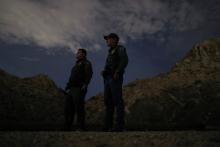
All data indicate that undocumented migration from Mexico, in particular, has ended and at this point more unauthorized Mexicans are leaving the country than entering it. According to estimates from the Pew Hispanic Center, the Center for Migration Studies and the Department of Homeland Security, the undocumented Mexican population stopped growing in 2008 and has been trending downward ever since.

The current outrage around families being detained and separated is important, but we must bear in mind that it aligns with a national history. Our Native siblings had their land taken from them, their families wiped out so the U.S. could be “founded.” My own ancestors had their children ripped away from them during slavery sales. Our Japanese siblings were placed in armed internment camps during the second World War — a history that this nation has often tried to avoid as much as possible. Last year, we saw an attempt to block immigrants and refugees from primarily Muslim nations, commonly known as the “Muslim Ban.”

Kevin Landy, a former ICE assistant director responsible for the Office of Detention Policy and Planning under the Obama administration, said the move to house so many detainees at once in federal prisons was “highly unusual” and raises oversight concerns.

But back to the wall idea, which President Trump said could easily be built by the Army Corps of Engineers, because they’re, you know, in the army right? He assured skeptical Pentagon officials that the $20 billion would be more like a loan, because, duh, Mexico would pay it back. In fact, U.S. negotiators are already working with their Mexican counterparts to establish the precise terms of repayment. Asked if he prefers reimbursing the American treasury with a lump sum or in monthly payments, Mexican president Enrique Peña Nieto replied, pleasantly, “How about nada? Does nada work for you?”

“We have been angered about the detention of our undocumented members and allies from the New Sanctuary Coalition,” said Onleilove Alston, the executive director of Faith in NY, a multi-faith and multi-race network of over 70 congregations working for justice in New York City. “We know that God doesn’t create anyone illegal but that everyone is created in the image of the divine. Now is the time for congregations to stand with stranger as the Bible commands, and now is the time for clergy to put their bodies on the line for those in the shadows.”

An ICE officer told the Daily Camera that Jurado’s detainment is not related to Encalada Latorre’s immigration status or her taking sanctuary. But some, including Encalada Latorre and Janette Vizguerra, a prominent immigrant rights leader who was previously in sanctuary, believe that this is a tactic to put pressure on Latorre to leave sanctuary.

When the Magi told King Herod about the heaven-sent child they’d come to honor, Herod also issued an executive order — kill every Hebrew child under 2. Herod’s henchmen would have slaughtered the Christ child along with the others had his parents not acted quickly to cross a border and protect their baby. Mary and Joseph were dreamers before Jesus. To prepare for Christmas is to remember Mary and Joseph’s dream and the civil disobedience it inspired.
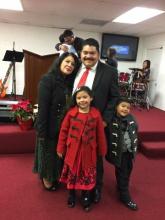
They handcuffed me and searched me, and another officer said that they were taking me to the detention center in Adelanto. I had heard a lot about that detention center, but I never imagined how terrible that place actually is. I had a very bad experience there. I had a cold during the first few days of being there and I was not receiving any kind of medical attention.
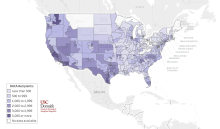
An interactive map, courtesy of USC Dornsife's Center for the Study of Immigrant Integration, illustrates estimated numbers of populations who are DACA eligible, and numbers of actual DACA recipients by congressional districts. In the aftermath of the abolishment of DACA, the Department of Homeland Security has set a deadline for all individuals eligible to renew DACA by Oct. 5.

Trump received pressure from many conservatives: Texas Attorney General Ken Paxton and nine other state attorneys general threatened to sue the administration if he didn’t announce an end to the program by Sept. 5, next week. Trump has not been clear about a decision, but during his campaign promised to terminate the program along with all other immigration executive orders by President Obama

Thousands gathered in front of the White House on Tuesday calling on the administration to protect the Deferred Action for Childhood Arrivals, the executive action signed by President Barack Obama that protected 800,000 young people from deportation. They were able to receive work permits and stay in the U.S. in exchange for providing their information and going through background checks. Now, DACA is in the hands of the Trump administration — and the program is under threat by Texas Attorney General Ken Paxton and nine other state-level officials who plan to sue if the Trump administration does not cancel DACA by Sept. 5.
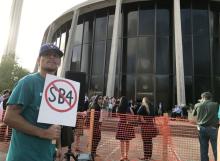
A U.S. district judge in Austin has rejected an effort by Texas to have a law that would punish so-called sanctuary cities be declared constitutional ahead of the measure taking effect next month. The Republican-backed law is the first of its kind since Donald Trump became president in January, promising to crack down on illegal immigration. Texas is the U.S. state with the longest border with Mexico.

Pastor Craig Paschal says the decision to turn his church into a sanctuary, and a focal point in the nationwide immigration debate, was not easy but he considered it a Christian duty.
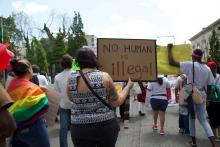
Sessions v. Dimaya
This case concerns the scope and definition of a federal immigration statute that allows deportation of non-citizens who committed an “aggravated felony.” An immigration court ruled that burglary constituted a “crime of violence,” but the Ninth Circuit Court reversed the immigration court’s decisions, stating that the term “crime of violence” is unconstitutionally vague.

By the time I learned to read, Juana’s eldest daughter Lesvi was suffering from a life-threatening illness in Guatemala. She returned to care for her daughter, risking her own safety to make the dangerous trek. When she returned to the U.S., she learned that not only would her asylum status be denied, but she would be ordered to leave the country. But she couldn’t. Her child needed medical care.

Kelly said in a statement on Thursday he was rescinding the initiative, known as DAPA, because "there is no credible path forward to litigate the currently enjoined policy."